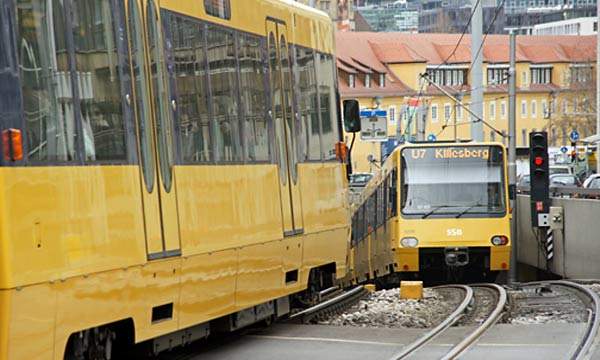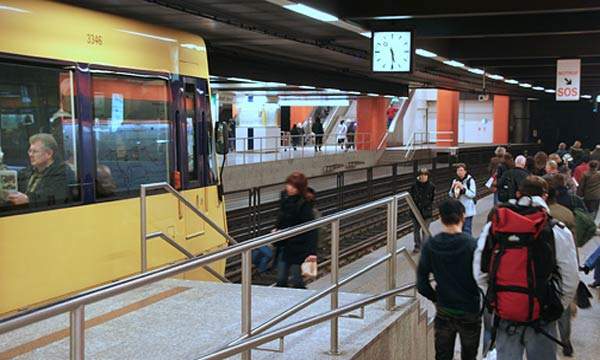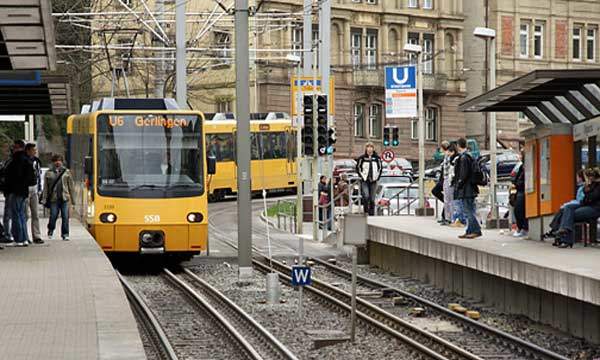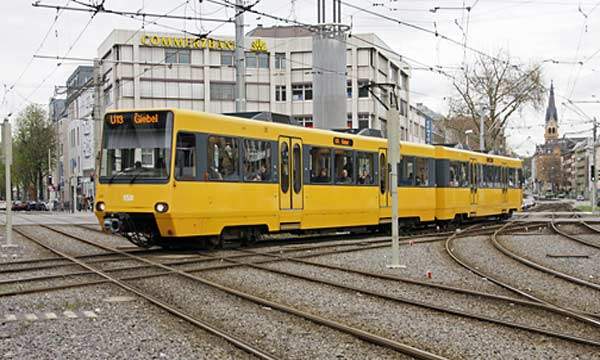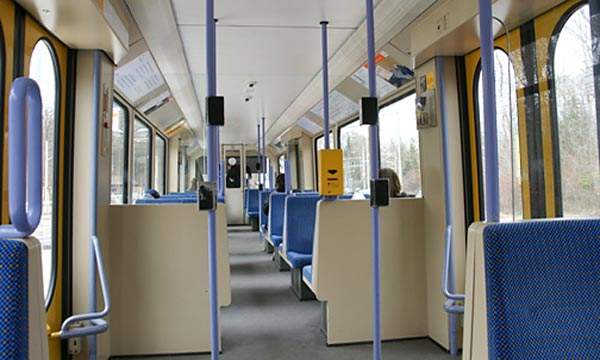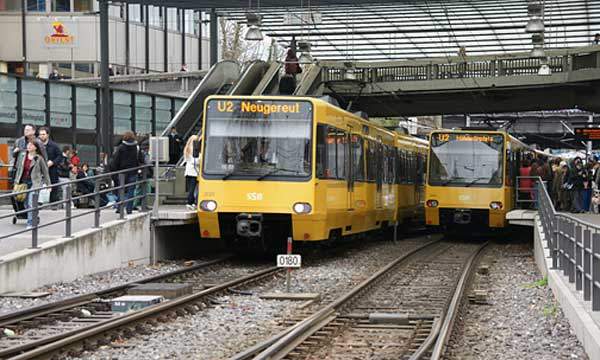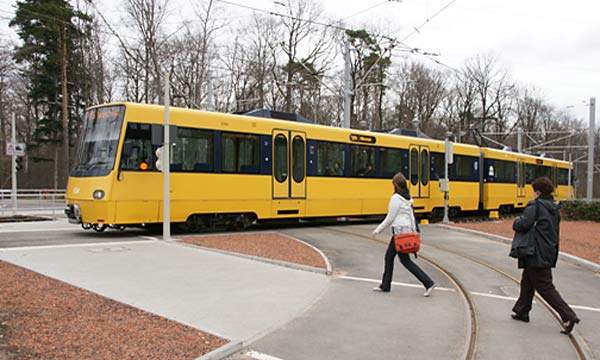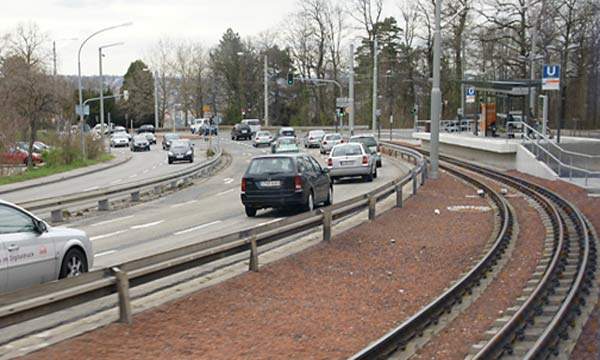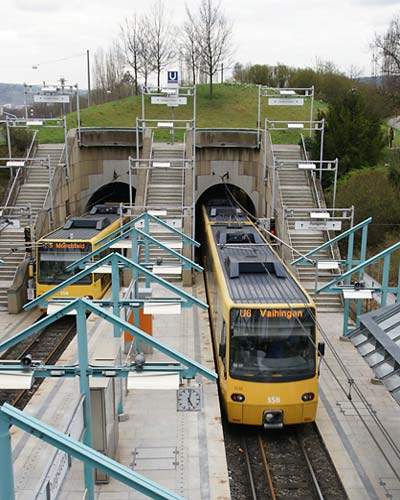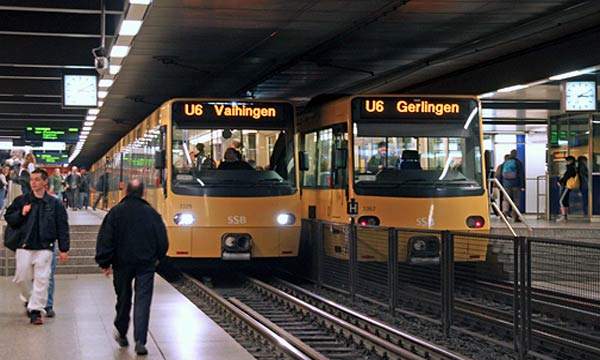Capital of the state of Baden-Württemberg, Stuttgart and its surrounding towns occupy a hilly area of south-west Germany. As well as its ‘motor city’ identity as home to Daimler (Mercedes) and Porsche, Stuttgart is an important hub of regional and long-distance train services. It is also the location of an unusual light rail network that has now, but for a museum service, supplanted an earlier tram system.
THE PROJECT
The enduring prosperity of the Stuttgart area encouraged a process of urban sprawl that as early as the 1950s had prompted studies to separate road traffic from the existing metre-gauge tramway. As was to be later adopted in Köln and Düsseldorf, this was achieved by placing urban rail in new tunnels, mainly in the city centre, with construction beginning during 1962.
Although a comprehensive network, the metre-gauge tramway had then neither the reach nor, even if extended, the capability of handling foreseen demand.
In 1976 local government decided to create a 1,435mm light rail system (Stadtbahn: unconnected with the S-Bahn format of which DB now operates six routes around Stuttgart) which would eventually replace the trams, thereby leading to a gradual takeover of the network by light rail. This led to an era of traditional tram and modern light rail systems in joint operation that lasted until December 2007.
Along with bus routes as an integral part of operator Stuttgarter Strassenbahnen AG’s (SSB) services, the Standseilbahn funicular and the metre-gauge Line 10 Zahnradbahn (‘Zacke’) rack railway were not directly involved in the transition.
INFRASTRUCTURE
To maintain free running, the light rail system mainly uses dedicated alignments free of interruption by road traffic. By 2002, of the system then just under 120km long, around three quarters had its own alignment, with high kerbs being used for separation where tracks accompany roads. But for the presence of ‘U’ signage at street level in central Stuttgart, it is possible to be unaware of the city having a major light rail system, as its 24km of tunnels are largely in that zone.
In keeping with the prevailing high quality on the network, in most cases Stuttgart has pursued a policy of stops being in the open air, several being in cuttings created for this purpose, as at the Pragsattel interchange which has the rare distinction of being overlooked by a vineyard.
Although the two different vehicle types shared alignments on dual-gauged track and a common overhead power supply of 750V dc, level access to the new light rail vehicles called for ramp or lift-connected high-level platforms a metre above the rail, as opposed to near-ground level access to the outgoing high floor tram fleet.
A legacy of this era is the continued presence of the two levels at some stops, notably at Hauptbahnhof Arnulf-Klett-Platz, also of the three-rail tracks, some being left to allow museum trams to run.
Reconstruction of the U15 line for light rail, reopened in 2008, included an extra rail for use by the heritage vehicles on this scenic route up to Stuttgart’s broadcasting tower. At the Ruhbank Fernsehturm stop a turning circle has been installed for the trams which are being relocated to the new SSB museum, due to open at Bad Canstatt in summer 2008.
As well as some paved and grassed finishes, most lines are of traditional flat-bottomed rail, laid on wooden sleepers placed on ballast, believed by SSB to be more economical and easier to maintain than grooved rail in concrete. There are three maintenance depots and, to counter the threat of vandalism, other facilities offering secure storage of stock.
ROLLING STOCK
From several prototypes made by MAN at Nürnberg from 1982, the DT8 (Doppeltriebwagen, eight-axle) series was developed specifically for the SSB Stadtbahn which features many steeply graded sections. They were produced by Düwag and Adtranz and their successors, with deliveries beginning in 1985. To account for places where a high platform could not be installed, earlier units had retractable steps fitted.
As the standard gauge system grew, more orders have created a fleet of 164 DT8 units. Three braking systems are fitted, electro-dynamic, pneumatic and magnetic. The DT8.10 series introduced gangway connection between the two cars in the unit. The type reached 140km/h during testing, although in everyday use a system restriction of 80km/h (50mph) applies.
SSB feel that the high-floor fleet, developed in format before the widespread advent of the low-floor tram, gave ease of maintenance and the passengers more interior space, a consistent floor height and better isolation from equipment noise.
SIGNALLING/COMMUNICATIONS
With the system having dedicated colour light signals and being designed to minimise conflict with other transport modes, there are relatively few points at which the light-rail priority traffic signals are required. Real-time information is provided at stops and on vehicles, the latter including ‘string of pearls’ light displays showing progress along the route.
As well as on display screens, digitised speech announces the stops, with volume adjusting to take account of ambient noise levels in the vehicle. SSB introduced a programme of installing Wi-Fi hotspots around the system.
THE FUTURE
Designed for a long working life and according to Stuttgart’s particular needs, DT8 vehicles will remain in service for several decades, although expansion may require further orders. Closed with the tram network, the northern section of U15 from Zuffenhausen to Stammheim is to be rebuilt for a Stadtbahn service, and extensions of other lines are planned, each featuring a mix of tunnel and surface running.
The city appears set for radical reworking of its rail-based public transport under the now approved but still contested ‘Stuttgart 21’ project. Incorporating the removal of surface heavy rail and its reorientation beneath the Hauptbahnhof, these and other works lasting several years will force the restructuring of the light rail network at several points.

